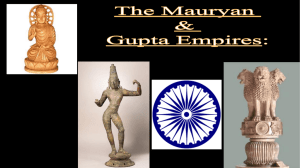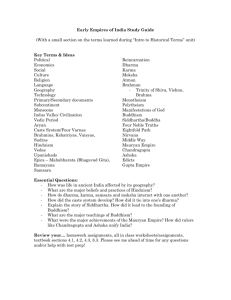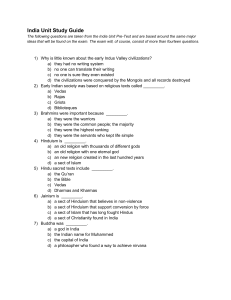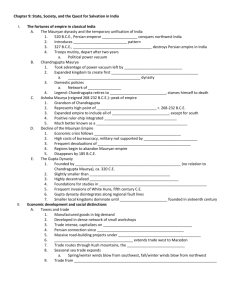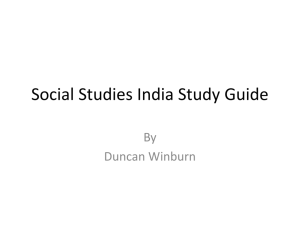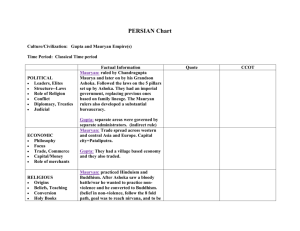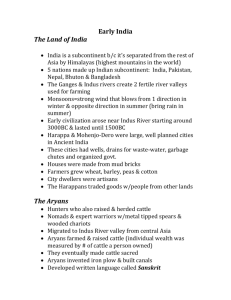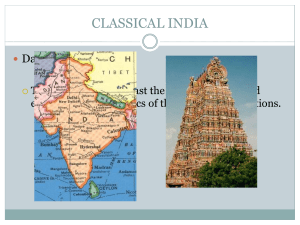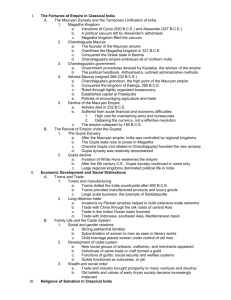Packet 7
advertisement
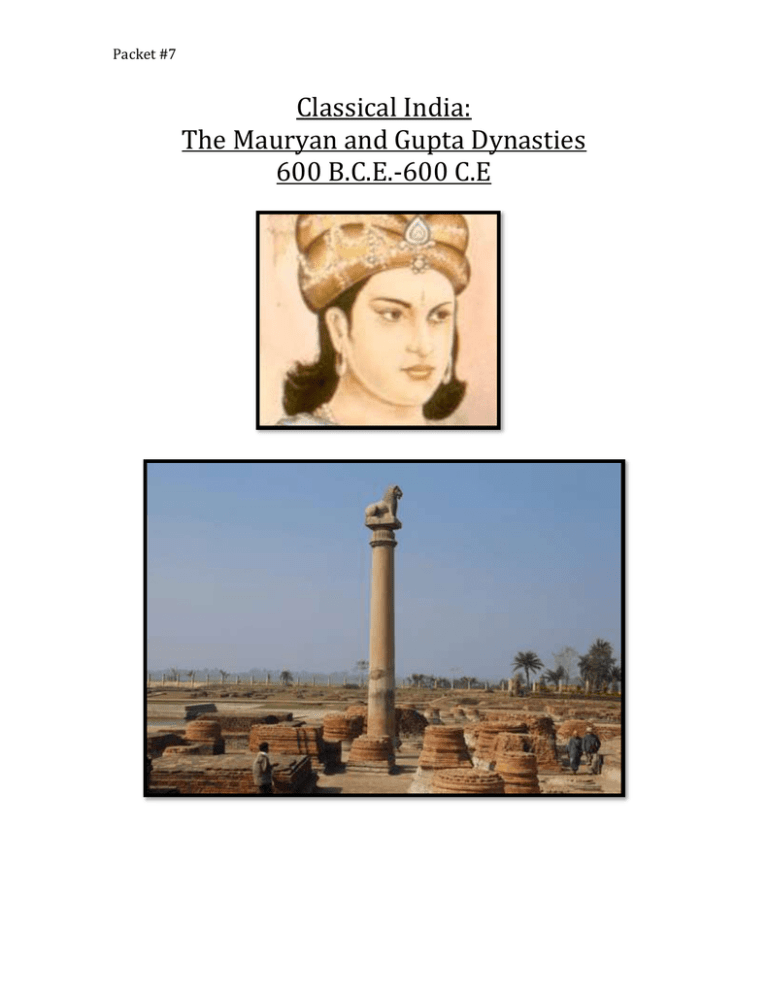
Packet #7 Classical India: The Mauryan and Gupta Dynasties 600 B.C.E.-600 C.E Packet #7 This packet includes information on the following topics: The Mauryan and Gupta Dynasties (321 BCE-550 CE) Chandragupta Maurya and the Mauryan Dynasty 321-185: During the late 320s B.C.E. an ambitious adventurer named Chandragupta Maurya centralized and unified the government of most of the Indian subcontinent. By 432 B.C.E. he had overthrown the ruling dynasty and consolidated his hold on the kingdom. o Supposedly he abdicated the throne, became a monk and an ascetic and starved himself to death. Political: An advisor named Kautalya devised procedures for governing Chandragupta’s realm. His advice survives in the Arthashastra handbook, a manual offering detailed instructions on the uses of power and the principles of government. o He advised Chandragupta to make use of spies. His advice oversees trade, tax collecting, agriculture etc. o The together built a bureaucratic administrative system that ensured governance throughout the state. Ashoka: Chandragupta’s grandson. The high point of the Mauryan Empire. Ashoka was a conqueror. When he came to power, the only major region that remained independent of the Mauryan empire as the kingdom of Kalinga. As emperor he sought to conquer Kalinga and bring it under Mauryan control. It was a bloody campaign in 260 B.C.E. About100,000 Kalingans died and 150,000 were driven from their home. o Ashoka ruled through a tightly ruled bureaucracy. o He communicated his policies by inscribing edicts in natural stone formations or on pillars that he ordered erected. They are known as the rock and pillar edicts (pictured on cover). o He converted to Buddhism after seeing the devastation in Kalinga. Buddhism did not gain much ground in India. Financial difficulties led to the end of the dynasty. Gupta: 320-550 CE Smaller than Mauryan Arose 500 years after the fall of the Mauryan Empire. Before the Gupta Empire, what remained of the Mauryan Empire was lots of small independent states under the rule of kings Organization was considerably different Samudra Gupta and Chandra Gupta II conquered many of the regional kingdoms of India, and they Packet #7 established tributary alliances with others that elected not to fight. The Gupta dynasty brought stability and prosperity to the subcontinent. Ashoka had insisted on knowing the details of regional affairs which he closely monitored from his court. The Guptas left local government and administration, and even the making of basic policy, in the hands of their allies in the various regions of their empire. Declined after invasion by nomadic people from central Asia Large regional kingdoms dominated political life in India during the millennium between the Gupta and the Mughal dynasties Culture: Great achievements in math Indian numerals included “0”Indian math calculated the value of pi and the length of the solar year. Gender: o Women were largely subordinate to men. Women were portrayed as weak willed in literature and exalted wives who devoted themselves to their husbands. o By the Gupta Dynasty, child marriage was common. 8 and 9 year old girls were betrothed to much older men. o Women’s work was in the home. Social Order: o Aryans recognized four main castes or classes of people: Brahmins (priests), kshatriyas (warrior and aristocrats), vaishyas (peasants and merchants), shudras (serfs). Religion: o Ancient Indian religion revolved around ritual sacrifices offered by Brahmin priests in hopes that the gods would reward their loyal human servants with large harvests and abundant herds. Jainism: believe that everything in the universe-humans, animals, plants, the air, bodies of wa ter, and inanimate physical objects like rocks—possessed a soul. As long as they rmained trapped in terrestrial bodies, these sous experiencd both physical and psychological suffering. Only by purification from selfish behavior could souls gain release from their imprisonment. Demands rigorous asceticism Buddhism: Siddhartha Gautama (pictured) born in 563 bce was the founder. He left his family in 534 bce to lead the life of a holy man. He wandered searching for spiritual enlightenment and an explanation for suffering. He meditated for 49 straight days under a bo Packet #7 tree where he received enlightenment: he understood both the problem of suffering and the means by which humans could eliminate it from the world. At this point, Guattama became the Buddha—the enlightened one (more on Buddhism in its own packet). Jains and Buddhists did not recognize social distinctions based on caste. Appealed to members of lower castes. Hinduism: Drew inspiration from the Vedas and Upanishads, popular Hinduism increasingly departed from the older traditions of the Brahmins. Hinduism displaced Buddhism as the most popular religion in India. Hinduism attracted political support and patronage, particularly from the Gupta emperors. The Guptas and their successors helped Hinduism become the dominant religion and cultural tradition in India. It would almost completely dominate the subcontinent until it was challenged by Islam. Although an imperial state did not bec ome a permanent feature of Indian political life, the peoples of the subcontinent maintained an orderly society based on the caste system and regional states. Economy: Agricultural surpluses encouraged the emergence of towns, the growth of trade, and further development of the caste system. Flourishing towns maintained marketplace and encouraged the development of trade. From India, long distance trade passed in two directions – west to the Mediterranean basin, and across the silk roads of central Asia to markets in China. Cotton, aromatics, black pepper, pearls, and gems were the principal Indian exports, in exchange for which Indian merchants imported horses and bullion from western lands and silk from China. During the Mauryan Dynasty, an increase in trade in the Indian Ocean occurred. Seaborne trade benefited especially from the rhythms of the monsoon winds. AS early as the fifth century BCE, Indian merchants had traveled to the islands of Indonesia and Southeast Asia. A robust agricultural economy supported the creation of large-scale states and interregional trade. Packet #7 SOCIAL POLITICAL ECONOMIC ENVIRONMENTAL Packet #7 Vocabulary Chandragupta Maurya Mauryan Dynasty Gupta Dynasty Kautalya Arthashastra Ashoka Kalinga Pillar Edicts Brahmins kshatriyas vaishyas shudras Jainism Definition Packet #7 Buddhism Hinduism Siddhartha Gautama
